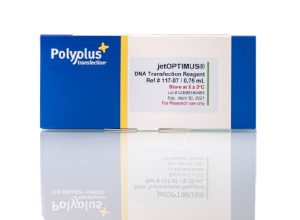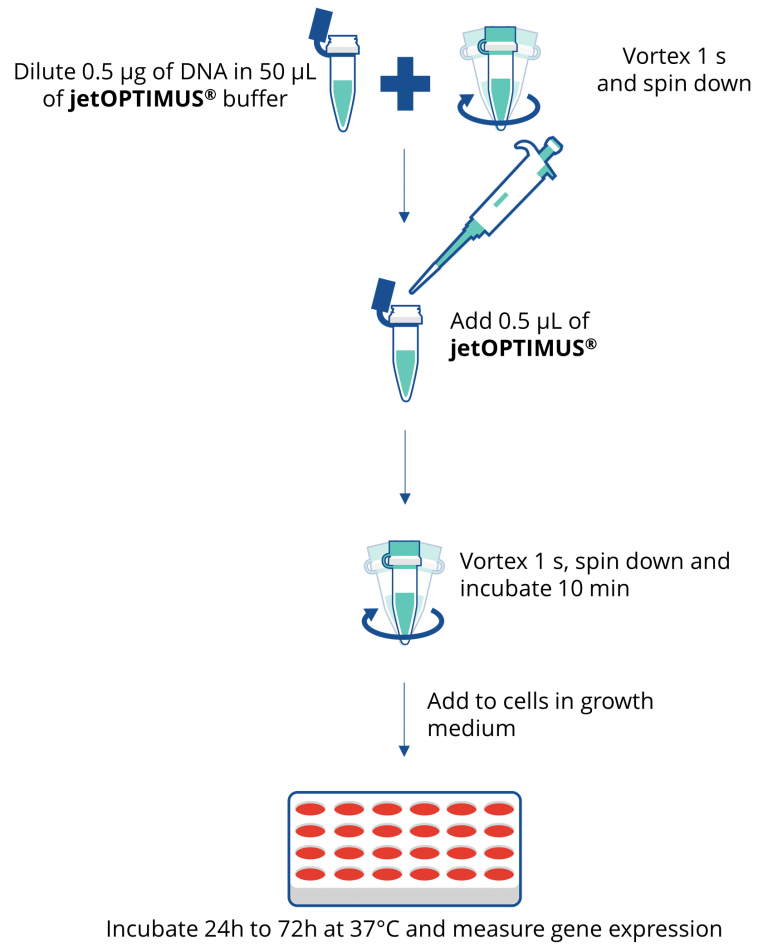

 下载产品说明书
下载产品说明书 用小程序,查商品更便捷
用小程序,查商品更便捷



 收藏
收藏
 对比
对比 咨询
咨询
Specifications
|
Reagent |
jetOPTIMUS® DNA Transfection Reagent |
|
Molecule delivered |
Plasmid DNA |
|
Applications |
Transient and stable gene expression from plasmid DNA transfection |
|
Cell types |
Adherent hard-to-transfect mammalian cell: |
|
Number of transfections |
1.5 ml of jetOPTIMUS® transfection reagent is sufficient to perform 3000 transfections in 24-well plates or 750 transfections in 6-well plates following the standard protocol |
|
Storage |
Store jetOPTIMUS® at 5 °C ± 3°C. |
|
Provided with |
jetOPTIMUS® Buffer |
Summary
Ace your DNA transfection in the cell model you need!
As Transfection Experts, we know that it is essential for biologists to work with physiologically relevant cell models. For gene expression studies, transfection is the preferred technique to introduce a gene of interest in a given cell model, due to its cost-effectiveness and simplicity-of-use in comparison to physical techniques (e.g. micro-injection, electroporation).
Several types of cells (primary cells, stem cells or cancer cell lines) remain difficult to transfect with DNA for different reasons: slow-dividing rates, cell fragility and cellular defense mechanisms. To address the current limits of DNA transfection and complement our existing gene expression portfolio (jetPEI®, jetPRIME®, jetMESSENGER®), Polyplus-transfection® engineered an innovative delivery nanoparticle: jetOPTIMUS®.
jetOPTIMUS® is a powerful transfection reagent that improves cellular uptake and endosomal escape of DNA in adherent cells (even in hard-to-transfect cells) resulting in higher transfection efficiency. In order to work in relevant physiological conditions, transfection with jetOPTIMUS® requires a minimum DNA quantity and reagent volume to keep an excellent cell viability and morphology.
Ordering information
|
Reference number |
Reagent size |
Buffer size |
|
101000051 |
jetOPTIMUS® 0.1 mL |
10 mL |
|
101000025 |
jetOPTIMUS® 0.75 mL |
2 x 60 mL |
|
101000006 |
jetOPTIMUS® 1.5 mL |
4 x 60 mL |
|
201000001 |
x |
jetOPTIMUS® Buffer 60 mL |
Description
Optimized DNA transfection efficiency on hard-to-transfect cells
jetOPTIMUS® is an innovative cationic nanotechnology developed to improve DNA transfection efficiency in easy- and difficult-to-transfect cells used as in vitro cell culture models. Tested on various primary cells and cell lines, jetOPTIMUS® proved its superiority by reaching higher transfection efficiencies and gene expression than main competitors.

Fig. 1: jetOPTIMUS® outperforms its main competitor. Transfection efficiency was assessed by FACS analysis in various cell lines 24 h after transfection with a plasmid coding for a GFP protein in 24-well plates. Conditions were set up according to the manufacturer’s recommendations both for Lipofectamine® 3000 and for jetOPTIMUS®.
Advanced nanotechnology: Superior gene expression using less material!
jetOPTIMUS® has been developed to increase transfection efficiency into a wide range of cell types, while keeping the amount of DNA as low as possible, and reducing the volume of reagent required compared to main competitors. Consequently, scientists can increase the number of transfections and reduce the cost per reaction by up to seven-fold (table 1).

Table 1: Lower volume of jetOPTIMUS® is required compared to Lipofectamine® 3000 in 24-well plate.
Excellent cell viability and morphology
Reaching high transfection efficiencies is often at the expense of cellular integrity, with adverse effects on cell cycle, metabolism and signaling pathways. At Polyplus-transfection, we make no compromise on cell integrity: jetOPTIMUS® transfection reagent is gentle on cells, allowing generation of biologically relevant data from gene expression studies.

Fig. 2: Cells remains healthy and keep a good morphology 24h after transfection. Phase contrast microscopy of both MDCK and VERO cells 24 h after transfections with a plasmid coding for a GFP protein performed according to the manufacturer’s recommendations for each reagent.
Optimized transfection protocol
jetOPTIMUS® is a ready-to-use transfection reagent provided with its own complexation buffer (jetOPTIMUS® Buffer). The protocol is optimized for simplicity of use (all plate sizes), culture medium compatibility (antibiotics, serum) and cost-effectiveness (lowest amount of DNA and volume of reagent).

Fig. 3: Simplicity of the jetOPTIMUS® protocol for DNA transfection, here in 24-well plates.









 危险品化学品经营许可证(不带存储) 许可证编号:沪(杨)应急管危经许[2022]202944(QY)
危险品化学品经营许可证(不带存储) 许可证编号:沪(杨)应急管危经许[2022]202944(QY)  营业执照(三证合一)
营业执照(三证合一)